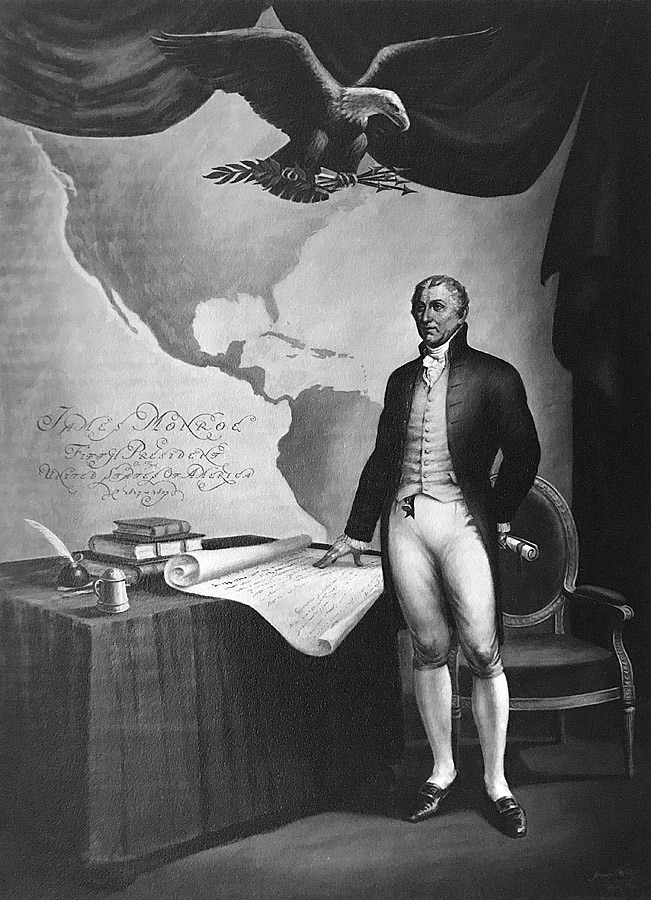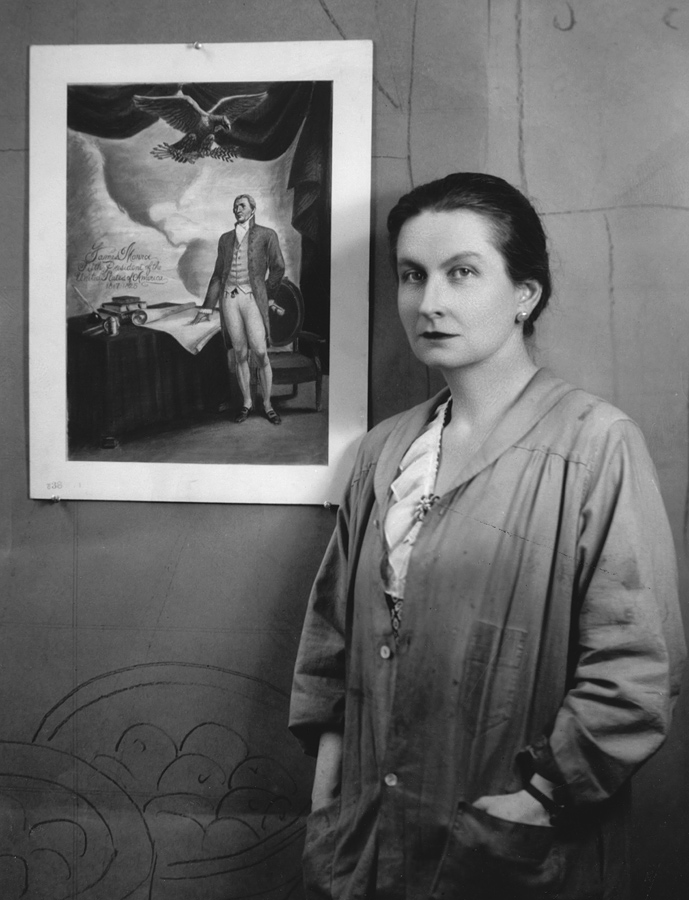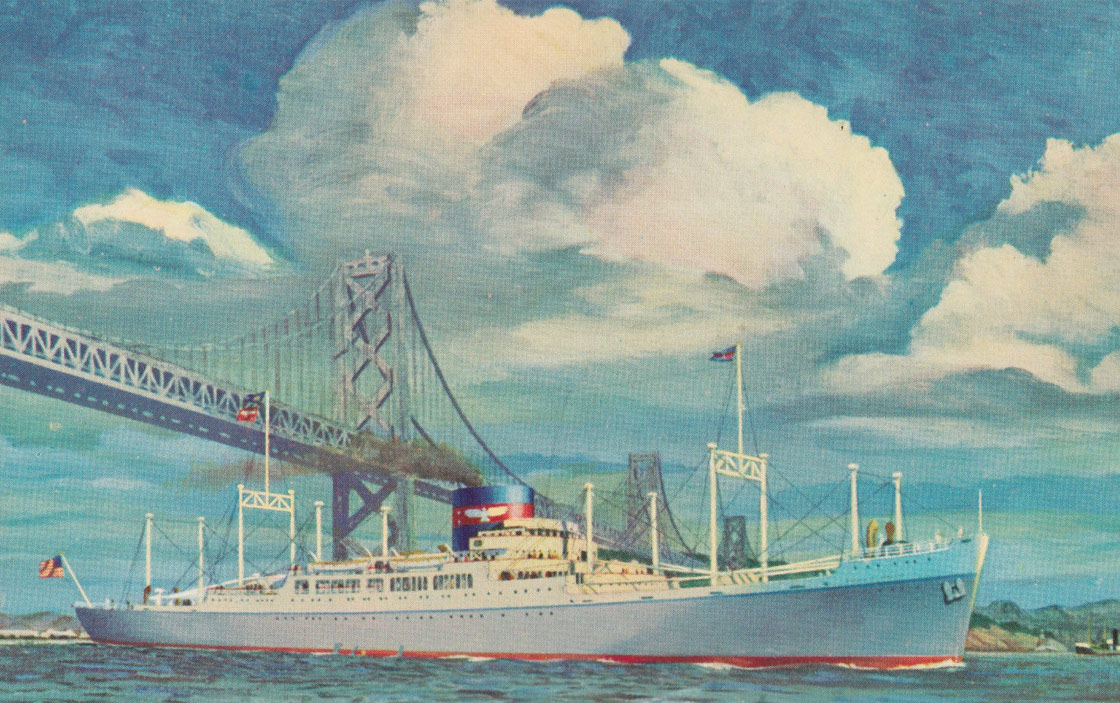Hildreth Meière Documentary Series - Watch Trailer
Hildreth Meière Documentary Series - Watch Trailer
Medium: oil on canvasExecuted by: Hildreth MeièreNonextant

James Monroe, Fifth President of the United States, 1817-25
As an overmantel panel for the lounge on the promenade deck of the S.S. President Monroe, Hildreth Meière painted a large canvas of James Monroe, Fifth President of the United States, 1817-25. Commonly known as the “hall,” the lounge was 36’6” long, 20’ wide and 16’8” high.

Painting of James Monroe, Fifth President of the United States, 1817-25 in ship’s hall
In order to be awarded the commission for this Federal Art Project, Meière had entered a competition organized jointly in 1940 by the Section of Fine Arts and the United States Maritime Commission to provide artwork for the interiors of the S.S. President Jackson, the S.S. President Hayes, and the S.S. President Monroe.1 These three identical ships designed by the Maritime Commission were to become part of the American President Lines.2
In designing the new ships for the American President Lines, the U.S. Maritime Commission’s Interior and Styling Unit stressed maximum comfort and informality, avoiding the grandiose method of decoration that has been acceptable without question the last few years. . . . The shipbuilders of the last decade made the disastrous mistake of subordinating interior design to utility. The decorator was compelled to adapt his ideas to spacing that had almost no possibilities whatever. Today, however, complete consideration of art and architecture is in the hands of the same people, thus insuring art its rightful importance and maintaining harmony throughout.3
The mural for the hall on the promenade deck was to meet the following specifications:
In the center of the forward bulkhead above the fireplace there will be a mural approximately 7’ wide and 10’ high. The bottom line of the mural will be 4’10” above the deck.”4
Materials and mediums were optional:
Carved or painted marinite, marine veneer or linoleum may be considered as materials for the decoration. Oil paints or colored lacquers may be considered as a medium. Tempera on gesso-grounded vehisote panel may also be used.4
The artist would be paid $1330.4
Although it was not a relief project, the competition was fierce:
. . . four hundred and sixty-two artists submitted one thousand four hundred and sixty-two designs of better than average merit. This was the first anonymous, national competition for decoration of American ships, hence stimulating a great deal of interest among eager, untried painters, also serving to introduce many fine artists to the layman.7
Meière won the competition to decorate the overmantel and was photographed in front of her winning entry for the painting, which is no longer extant. The scale of her submitted design was two inches to the foot in full color, mounted, with a two-inch-wide white border.8

Meière with photograph of her winning submission to the Section of Fine Arts/Maritime Commission Competition of 1940
In addition to Meière who painted the hall overmantel, artists R. Phillips Sanderson, David Swasey, Allan D. Jones, Jr., and Philip Guston were selected to provide decoration for different areas of the ship in various mediums.9
The S.S. President Monroe launched August 7, 1940 and was delivered to the American President Lines in December.
. . . the Monroe [was] placed in the round-the-world service just when Italy invaded France and President Roosevelt declared the Mediterranean an additional combat area. Most of the round-the-world ships were rerouted around the Cape of Good Hope or returned to their home port of San Francisco across the Pacific.10
Refitted by the Navy as the U.S.S. President Monroe in July 1943, the ship participated in campaigns throughout the Pacific—in the Gilbert Islands, Marshall Islands, Marianas, Luzo, and Iwo Jima, receiving five battle stars for service in World War II. In 1946, the U.S.S. President Monroe was decommissioned and returned to the American President Lines for merchant service once again as the S.S. President Monroe. The ship was sold to the Greek Shipping Company in 1965 and scrapped in 1973.11

Painted postcard showing the S.S. President Monroe, 1960
None of the entries was signed. The artist’s name was sealed in an envelope which was then given a number. Meière’s entry was number MC 38. “Announcing Important National Mural and Sculpture Competitions Open to All American Artists,” Section of Fine Arts, Public Buildings Administration, Federal Works Agency Bulletin 21 ( March 1940): 8.
Chandler de Brossard, “New York: Mural Designs for American Ships: A Federal Art Project,” London Studio 21 (Studio 121) (Fall 1941): 61.
De Brossard, p. 61.
Bulletin 21, p. 15.
Bulletin 21, p. 15.
Bulletin 21, p. 15.
DeBrossard, p. 61.
Bulletin 21, p. 14.
“Announcement of National Competitions,” Section of Fine Arts Bulletin 22 (September 1940): 18. All information on the competition was provided by Wayne Yanda.
John Niven, The American President Line its Forebears, 1848-1984 (Newark, Delaware: University of Delaware Press, 1987): 143.
For the history of the U.S.S. President Monroe, see www.navsource.org/archives/09/22/22104.htm